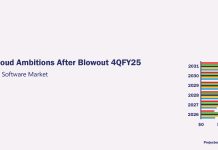Oracle, never one to cede ground to any of its software rivals, is making a strong comeback for its evolving HCM Cloud strategy.
At a recent analyst event, Oracle HCM Cloud executives laid out a compelling application roadmap along with recent customer wins that underscored the vendor’s rebound. This comes at a time as Oracle is staving off competition in a market where it used to call the shots after acquiring PeopleSoft and Taleo to dominate Core HR and eRecruiting.
Having signed more than 1,600 customers for Oracle HCM Cloud and turned 1,000 of them live, the database giant is once again making its presence felt among some of the biggest companies in the world by becoming their system of record for Core HR and Payroll – this time with a real-time engine that can be accessed via the Cloud by anyone in more than 116 countries. The vendor cited a single customer on Oracle HCM Cloud completing a W2 run that covered over 330,000 annual pay slips.
There were other milestones. Long-time customers like AXA, Pella, and Xerox have succeeded in migrating their legacy HR systems to Oracle HCM Cloud. During last week’s earnings call, CEO Mark Hurd said it signed 206 new Oracle HCM Cloud customers and 217 additional Oracle HCM Cloud deals with existing users for its third quarter of fiscal 2017. Household names like Berkshire Hathaway, Hertz Corp. and Tesco have signed on to run Oracle HCM Cloud.
Based on the latest figures from the Big Three HCM Vendors – Oracle, SAP and Workday are now running neck and neck in terms of the number of Core HR customers in the Cloud, as shown in the following table.
| Vendor | Number of Core HR Customers in the Cloud | Source |
|---|---|---|
| Oracle | 1600 | Oracle HCM Cloud Analyst Event, February 2017 |
| SAP | 1580 | SAP SuccessFactors Analyst Briefing, March 2017 |
| Workday | 1528 | 4QFY17 Earnings Call, February 2017 |
Source: Apps Run The World, March 2017
Any of the Big Three has barely scratched the surface
For starters, the 1,600 customer count that Oracle has achieved is a fraction of the addressable space for Oracle HCM Cloud, which typically targets companies with more than 1,000 employees. There are more than 20,000 organizations in both the public and private sectors that fit that bill.
Within Oracle’s installed base, there are more than 5,000 organizations running Core HR and/or Payroll systems, based on our Buyer Insight Database.
Some have been running different onpremise versions of PeopleSoft Enterprise for decades, others are on E-Business Suite for Core HR and Payroll, not to mention a few more on JDE Workforce Management. Additionally, there are thousands companies running Taleo for eRecruiting.
Over the next five years, Oracle HCM Cloud could be adding up to 3,000 net new customers, while migrating hundreds of its onpremise HR customers to the Cloud in a given year.
While Oracle Senior Vice President Chris Leone, who is in charge of Oracle HCM Cloud, declined to project how many more customers to add and in what time frame, it’s clear that the race is on for the Big Three to reach the important milestone of 10,000 Cloud HCM customers in the 1000-employee-and-above category.
Leone is bullish about its prospects by laying out the vision of delivering industry-specific HCM solutions in the Cloud, a much sought after HR Help Desk for the Cloud targeting PeopleSoft users that have long depended on the desktop version of HR Help Desk, as well as enhancements in learning, mobility, talent management and work-life balance.
Similar to anything from Oracle, the attention to the stack value has never been more evident than in Oracle HCM Cloud. HR Help Desk for the Cloud is built natively on the same data model as with the rest of Oracle HCM Cloud, eliminating any need for integration. Also a single security model ensures consistent data privacy especially for companies that operate in multiple countries with different data sovereignty rules.
Oracle HCM Cloud has already done well in professional services, financial services and manufacturing. In the coming year, it is gearing up for releases tailored for specific verticals like grant management for higher education, public sector payroll for the US federal government, and more localizations for key countries similar to Statutory Absence for UK employers found in Release 12.
Despite making such progress over the past few years, it has not been smooth sailing for Oracle HCM Cloud.
For years, Oracle has ruled the HCM market with some of the best-selling software applications for millions of users. It started with its E-Business Suite, which has won solid support for its compensation workbench, eLearning as well as core HR and Payroll modules. Its presence in the HCM market expanded with the 2005 acquisition of PeopleSoft – arguably the most influential HRMS system ever written – as well as Taleo for its widely popular talent acquisition products. In other words, it had the trifecta under its belt.
Then, the Cloud derailed its strategy, causing as much soul searching as software rewriting in order to meet the real-time needs of a new generation of Cloud users.
A much different competitive landscape dotted with well-funded startups like Benefitfocus, iCIMS and Workday emerged, taking the wind out of Oracle’s sails and keeping its HCM strategy in check.
Now it appears that Release 12, the current version of Oracle HCM Cloud, is gaining traction among some of its biggest customers, while laying the ground work to scale out with the Release 13, which promises to extend its reach into other strategic markets such as the Middle East, healthcare and higher education where it used to have a captive audience with a legion of PeopleTools developers for the PeopleSoft Campus Solutions.
In order to scale out Oracle HCM Cloud, a few scenarios are likely to emerge.
- Oracle is investing heavily in such features as Global HR and Payroll, Talent Management and Work Life – along with seamless integration into its ERP Cloud – in order to appeal to organizations with more than 10,000 employees as well as their millennial users.
- The 40%+ attach rate of Oracle HCM Cloud and Oracle ERP Cloud suggests that thousands more Oracle’s big customers will be exposed to its HCM and Financials Cloud products. The critical issue is whether these customers are going to implement Core HR or Core Financials first, now that their enterprise-wide contracts will cover all kinds of Cloud products from Oracle. Compressing Oracle HCM Cloud implementation time will be key to sustaining its momentum.
- Given Oracle’s noncommittal stance on whether it will actually develop PeopleSoft 9.3(the current version 9.2 has been available since 2013), the strategy is to steer most – if not all – PeopleSoft HR customers to Oracle HCM Cloud. Putting HR Help Desk on Oracle HCM Cloud is a step in the right direction.
In conclusion, Oracle HCM Cloud seems to be firing on all cylinders. And the recent acquisition of NetSuite with the addition of some 25,000 ERP customers will open up new cross-selling and up-selling opportunities for Oracle HCM Cloud.
Given Oracle’s history of resorting to big and small acquisitions to fuel its growth in a hurry, the question is whether the Oracle HCM Cloud strategy will prevail in its current form. The answer may lie somewhere in between. By staging a strong comeback, Oracle HCM Cloud now stands shoulder to shoulder with competitors like SAP SuccessFactors and Workday. The test is how soon Oracle can leapfrog them with its stack advantage, something that remains the vendor’s most potent weapon.






